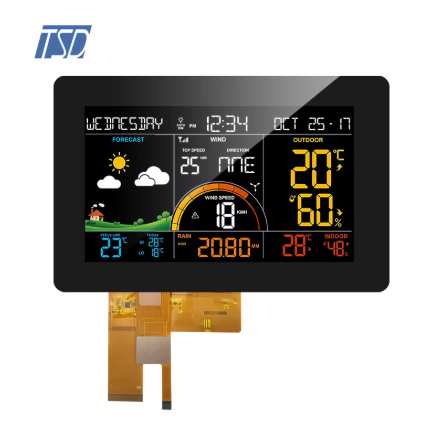Core Touch Technologies in TFT LCD Displays
Resistive Touch Technology
Resistive touch functions when pressure applied to the screen is sensed via the two separate flexible layers, the two layers separate when not pressed. This type of technology is very robust, and thus, is an excellent fit for industrial settings where durability is important to prevent wear and tear. Furthermore, resistive touch screens offer competitive cost and pen input acceptance, making them more suitable than capacitive devices for budget-constrained applications. The research demonstrates that capacitive touch technology has a promising performance on noise robustness but lower accuracy, while resistive screen exhibits high accuracy in the presence of noise across diverse conditions.
Capacitive Touch Systems
In capacitive technology, you use the body's numerous and distinctive electrical properties to track when and where the surface is being touched. Thanks to its high sensitivity, good sound quality and user experience (a smooth touch and response ), this technology is largely used in portable devices such as smartphones and tablets with whom it became very popular. Whilst capacitive systems tend to be more costly, they are able to support a larger spectrum of gestures exactly and are less susceptible to faking features by wrong activations. Recent stats showing capacitive subsuming over 70% of the consumer electronics touch screen market, indicating how dominant it is.
Infrared Touch Integration
Infrared touch-type technology employs a grid of infrared LEDs and sensors to detect touch with no covering layer on the screen, making the display bright and clear. Its construction is robust to suit outdoor or harsh environment applications and is glove friendly! It also fosters big screen environments suitable for public spaces such as museums and kiosks. Research reveals the growing preference for infrared touch technology in durability-focused industries looking for high-performance displays.
Advanced Touch Innovations for TFT LCD Applications
Optical Sensing and Time-of-Flight (ToF) Technology
Optical sensing technology applied to TFT LCD Applications receives touch information through light reflections: Users can operate freely and intuitively. When used with Time-of-Flight (ToF) technology, which measures an object’s distance using infrared light, it improves touch accuracy by a big margin. These advances are even more important for gesture interfaces and AR applications where precise touch is critical. Rise in adopttion of Optical and ToF Technologies Robust growth of over 20% is anticipated in integrated projection optical, ToF technologies This reflects the integration of these technologies throughout various end markets as the advantages of ToF continue to spread.
Aerial Touch Display Systems
An airborne touch system is a great leap forward in the interactive space that enables users to manipulate screens by waving their hands in the air. This forward-thinking interaction technique also offers a more sanitary option, as contact is not required, meaning it will be useful in areas where cleanliness is a priority, such as in hospitals. Its integration into modern user interfaces – increasingly also in cars and household devices – is particularly seamless. With many companies focusing on providing unique user experiences, forecasts indicate that demand for touch solutions (albeit placed in the sky) will see considerable growth.
Security-Enhanced Touch Solutions
Security enabled touch technologies provide biometric scanning capabilities (e.g. fingerprint recognition) to grant secure access to mobile phones and tablets. This touch solution is essential for any industry which requires the strictest security measures e.g. financial industry, datacentric environment. They mitigate the proliferation of cyber threats by lowering the risk of the unauthorized penetration. By 2025, it is expected the market for security enhanced touch solutions will grow by over 30%, as organizations increasingly consider at data protection and security in touch applications.
Factors Influencing Touch Technology Selection in TFT LCDs
Environmental Considerations
When you choose touch technology for your TFT LCD, you must consider the environmental conditions that may affect it. Touch solutions such as infrared and capacitive touch screens tend to have limited success in tough environmental conditions that include large temperature extremes, high humidity and exposure to dust or liquid. Here, resistive systems are favoured and typically used in industrial applications. The energy savings and power usage, are also need to be evaluated especially in institutes where sustainable activities are enforced. The experts are unanimous that knowledge of the environmental factors can dramatically increase product life and improve the reliability of touch technology in rigorous environments.
Application-Specific Requirements
User interacting ways and interface design requests determine that which kind of touch technologycan be used in TFT LCDs as different applications have different requests. For example, in healthcare, resistive touch screens are preferred because they are hard-wearing and easy to clean, while in consumer electronics capacitive touch screens tend to be favoured because they offer a slicker, more responsive user interface. It is important to consider the characteristics and demographics of the intended user, including age and prior technology experience, when deciding between a more intuitive or traditional interface. Robust case studies have demonstrated that tuning touch technology to the unique requirements of applications results in better user satisfaction and significantly increased engagement. Taking them into account, companies can adjust their development plans to create the products that perfectly match what users want.
Future Developments in TFT LCD Touchscreen Technology
Micro LED and TFT Hybrid Systems
The combination of Micro LED with TFT screens is expected to enable many breakthroughs in display brightness, efficiency and touch functions. As it sits, micro LEDs are far more power efficient than any of these alternatives (something that is very important for high-resolution touch devices) and provide great color reproduction, too. With growing need for wearables and portable electronics industries, hybrid systems adopting TFT and Micro LED technologies are expected to disrupt industries that need long battery time. Demand for these Micro LED hybrids are expected to rapidly expand according to experts and could be a key contender in taking the traditional TFT market by storm over the next ten years or so.
Sustainable Touch Technology Trends
Contemporary touch technology trends are now moving towards eco-friendly production, with an emphasis on cutting down on manufacturing wastage and ensuring product recyclability. The companies are concentrating on the usage of biodegradable raw materials and energy efficient manufacturing process, to cater to an increasing consumers preference for eco-friendly products. Provide implications for extracting the added value on the basis of global consumption trend that environmentally friendly solutions are becoming more popular with the public, sustainable touch technology should be inserted into production of different manufacturers. Reports indicate that sustainable touch technology is expected to grow at a significant rate, as the global movement for sustainability and more environmentally safe processes presses forward.
FAQ Section
What are the main types of touch technologies used in TFT LCD displays?
The main types of touch technologies used in TFT LCD displays include resistive touch, capacitive touch, infrared touch integration, optical sensing, aerial touch systems, and security-enhanced touch solutions.
How does resistive touch technology differ from capacitive touch technology?
Resistive touch technology operates by pressure exerted on a screen and is known for its durability and affordability, while capacitive touch technology relies on the body's electrical properties to detect touch and is prevalent in devices needing multi-touch functionality and sensitivity.




